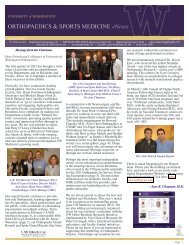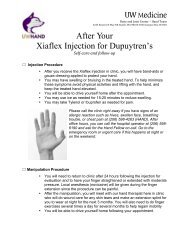2002 - University of Washington Bone and Joint Sources
2002 - University of Washington Bone and Joint Sources
2002 - University of Washington Bone and Joint Sources
Create successful ePaper yourself
Turn your PDF publications into a flip-book with our unique Google optimized e-Paper software.
Is the Absence <strong>of</strong> an Ipsilateral Fibular Fracture Predictive <strong>of</strong><br />
Tibial Pilon Fracture Severity<br />
DAVID P. BAREI, M.D., F.R.C.S.(C), SEAN E. NORK, M.D., CARLO BELLABARBA, M.D,<br />
AND BRUCE J. SANGEORZAN, M.D.<br />
The management <strong>of</strong> tibial pilon<br />
fractures remains controversial<br />
<strong>and</strong> challenging. Axial-loading,<br />
particularly from motor vehicle<br />
collisions or falls from significant<br />
heights, is a common mechanism <strong>of</strong><br />
injury. Principles <strong>of</strong> operative<br />
treatment include reconstruction <strong>of</strong> the<br />
distal tibial articular surface followed<br />
by restoration <strong>of</strong> mechanical axes.<br />
Anatomic reduction <strong>of</strong> the articular<br />
surface along with stable fixation<br />
allowing early motion has been shown<br />
to be the most important predictor <strong>of</strong><br />
satisfactory outcome, <strong>and</strong> should be<br />
prioritized. The ability to obtain<br />
anatomic reduction with stable<br />
fixation, however, decreases with<br />
increasing comminution <strong>of</strong> the<br />
articular surface.<br />
Fibular fractures are commonly<br />
associated with tibial pilon injuries,<br />
particularly those caused by shearingtype<br />
mechanisms. Other fracture<br />
patterns, however, do not demonstrate<br />
this associated feature. The absence <strong>of</strong><br />
an ipsilateral fibular fracture in patients<br />
with tibial pilon injuries may predict a<br />
more severe injury pattern to the tibial<br />
plafond. Presumably, the injurious<br />
energy is completely absorbed by the<br />
tibial plafond resulting in more severe<br />
epiphyseal <strong>and</strong> metaphyseal injury,<br />
precluding accurate reduction <strong>and</strong><br />
worse outcomes. Further, the<br />
deleterious effects <strong>of</strong> mechanical<br />
impact at the chondrocyte level may<br />
also lead to joint degeneration despite<br />
an accurate reduction. The purpose <strong>of</strong><br />
this study is to evaluate the difference<br />
in the radiographic severity <strong>of</strong> tibial<br />
plafond injuries with fibular fractures<br />
as compared to those without fibular<br />
fractures.<br />
MATERIALS AND METHODS<br />
Between January 1997 <strong>and</strong> February<br />
2000, 20 consecutive tibial pilon<br />
injuries without associated fibular<br />
fractures were retrospectively identified<br />
using a prospectively gathered trauma<br />
database. Over the same time period,<br />
an age <strong>and</strong> gender matched cohort <strong>of</strong><br />
20 tibial pilon injuries with fibular<br />
fractures were r<strong>and</strong>omly selected. A<br />
computer-based image editing s<strong>of</strong>tware<br />
program was used to digitize <strong>and</strong><br />
conceal the fibula on the initial<br />
anteroposterior (AP) <strong>and</strong> lateral<br />
radiographs on all 40 injuries. Care was<br />
taken to completely eliminate any<br />
fibular fracture, <strong>and</strong> associated fibular<br />
malalignment, on both the AP <strong>and</strong><br />
lateral views. Every effort was made to<br />
minimize concealment <strong>of</strong> the tibial<br />
plafond while maximizing the<br />
concealment <strong>of</strong> the fibula. Radiographs<br />
were then independently rank ordered<br />
(1 = least severe, 40 = most severe) by<br />
three orthopaedic traumatologists<br />
according to the severity <strong>of</strong> tibial<br />
plafond injury. Observers ranked all<br />
fractures taking into consideration all<br />
the radiographic factors they believe are<br />
important in the assessment <strong>of</strong> tibial<br />
pilon fracture severity. The observers<br />
were not given any specific guidelines<br />
regarding ranking, but relied on their<br />
significant clinical experience in<br />
managing these fractures. Injuries were<br />
also classified according to AO/OTA<br />
guidelines, which assigns fractures an<br />
alpha-numeric code according to body<br />
region <strong>and</strong> fracture location. Fractures<br />
affecting the metaphyseal <strong>and</strong><br />
epiphyseal portions are divided into A,<br />
B, or C-type groupings, indicating an<br />
extra-articular fracture, partial articular<br />
fracture, or complete articular fracture,<br />
respectively. The premise is that the<br />
increasing alpha assignment indicates<br />
a more severe fracture pattern, <strong>and</strong><br />
ultimately a worse prognosis.<br />
RESULTS<br />
Inter-observer agreement was<br />
assessed using the weighted Kappa<br />
statistic (k=0.6). Mean rank scores for<br />
pilon injuries with fibula fractures was<br />
24.4 while those without fibula<br />
fractures was 16.7 (T-test = 0.02). Rank<br />
order was repeated for only AO/OTA<br />
C-type pilon injuries <strong>and</strong> demonstrated<br />
a mean <strong>of</strong> 10.3 for those with fibular<br />
fractures <strong>and</strong> 8.7 for those without<br />
fibular fracture (T-test = 0.5). Mean<br />
rank order for AO/OTA B-type injuries<br />
was 11.1 whereas the mean rank order<br />
for C-type injuries was 24.5 (T-test =<br />
0.001). The proportion <strong>of</strong> fibula<br />
fractures in B-type versus C-type pilon<br />
injuries was assessed using the Chisquare<br />
statistic (p = 0.006).<br />
DISCUSSION<br />
Operative treatment <strong>of</strong> tibial pilon<br />
fractures is controversial. Evidence<br />
suggests that increasing comminution<br />
leads to a worse result for a variety <strong>of</strong><br />
reasons. Identifying factors that are<br />
associated with a given outcome aid in<br />
clinical decision making. It has been<br />
theorized that the absence <strong>of</strong> fibular<br />
fractures in association with ipsilateral<br />
tibial pilon injuries may be associated<br />
with a poor outcome. Two different<br />
potential scenarios are suggested: the<br />
first is that the injurious energy is <strong>of</strong><br />
lower magnitude <strong>and</strong> is insufficient to<br />
injure the fibula, or conversely, the<br />
energy is significant but is completely<br />
absorbed by the tibial plafond. To<br />
evaluate this theory, we used the rank<br />
order technique with experienced<br />
traumatologists blinded to the presence<br />
or absence <strong>of</strong> a fibular injury, who then<br />
independently assessed the<br />
radiographic severity <strong>of</strong> the tibial pilon<br />
fracture. The kappa statistic<br />
demonstrated satisfactory correlation,<br />
consistent with other published<br />
material on interobserver reliability <strong>of</strong><br />
the AO/OTA fracture classification<br />
system. This study demonstrates that,<br />
overall, tibial pilon injuries with fibular<br />
fractures are more severe than those<br />
without fibular fractures. Complete<br />
articular (C-type) injuries, with or<br />
without fibular fractures, are equally<br />
severe. Supporting the OTA<br />
classification, C-type injuries were<br />
consistently ranked as significantly<br />
more severe than B-type injuries. The<br />
presence <strong>of</strong> a fibular fracture was more<br />
frequently associated with C-type<br />
injury than B-type. This data suggests<br />
that the presence <strong>of</strong> an intact fibula in<br />
not predictive <strong>of</strong> a more severe injury<br />
to the tibial pilon, but is predictive <strong>of</strong> a<br />
less severe, B-type, injury.<br />
<strong>2002</strong> ORTHOPAEDIC RESEARCH REPORT 7















